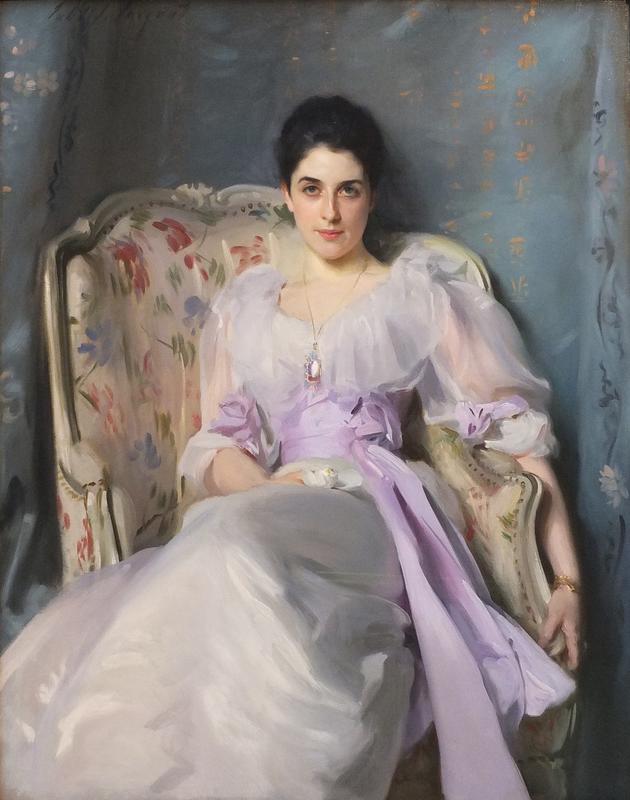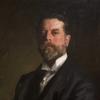More about Lady Agnew of Lochnaw

Sr. Contributor
This captivating portrait of the Lady Agnew of Lochnaw is John Singer Sargent’s redemption song.
After the shocking debut of Madame X earned Sargent a spot on the blacklist, he left the snooty Parisians for the land of tight-lipped Londoners. He crossed the pond and set up shop in his pal Whistler’s old studio and waited for the commissions to roll in. Unfortunately, his reputation preceded him and patrons were hesitant to hire the artist who flaunted scandalous collar bones at the Salon. To pass this otherwise unproductive time, he traveled to France and casually chilled with Monet. No big deal. There’s a big Impressionist mood going on here, in the way the light plays on the white of Lady Agnew’s dress.
It only took Sargent eight years to bounce back from the Madame X mishap. He eventually won over the hearts of London with this light and airy picture featuring pretty patterns, sumptuous textures, and a precocious grin. Andrew Noel Agnew – a lawyer, member of Parliament, and baronet of Lochnaw – commissioned this portrait of his newlywed, Gertrude Vernon, in 1892. Sargent exhibited the painting at the Royal Academy in 1893, prompting his successful career as a society painter. The commission actually benefited the Agnews as well, cementing Lady Agnew’s status as a beautiful, and therefore important, socialite.
Sargent made a killing on these society portraits, especially during the overly-regimented and wealth-conscious Edwardian period. Complex sets of rules governed every type of interaction and preserved the comforts of those who benefited from this stratification.
But, as Lady Agnew was soon to find out, social status was easy-come, easy-go, and not even a portrait done by the van Dyck of the fin de siècle could secure the Agnews’ social status forever. The couple struggled to keep up with the high cost of society life, and the Agnews eventually floundered. To offset the costs they incurred from one too many tea parties, Lady Agnew tried to sell this painting to Helen Clay Frick, daughter of the Frick Collection founder. After the Frick rejected the offer, the Scottish National Gallery also rejected the painting in 1924 on the grounds that the museum did not collect works by living artists. Luckily, Sargent died a year later and the museum said uhhh, we’ll take it.
Sources
- Driehaus Museum. “The Manners of the Edwardian Era.” Blog. http://driehausmuseum.org/blog/view/the-manners-of-the-edwardian-era. Accessed August 29, 2019.
- Fine Arts Museums of San Francisco. “The Scottish Visitors: Lady Agnew of Lochnaw.” Blog. https://www.famsf.org/blog/scottish-visitors-lady-agnew-lochnaw. Accessed August 29, 2019.
- National Galleries Scotland. “Lady Agnew of Lochnaw.” Art and artists. https://www.nationalgalleries.org/art-and-artists/5396/lady-agnew-lochn…. Accessed August 29, 2019.
- Weinberg, H. Barbara. “John Singer Sargent (1856–1925).” In The Heilbrunn Timeline of Art History. The Metropolitan Museum of Art. October 2004. https://www.metmuseum.org/toah/hd/sarg/hd_sarg.htm. Accessed August 29, 2019.
Featured Content
Here is what Wikipedia says about Lady Agnew of Lochnaw
Lady Agnew of Lochnaw is an oil on canvas portrait painting of Gertrude Agnew, the wife of Sir Andrew Agnew, 9th Baronet. The painting was commissioned in 1892 and completed the same year by the American portrait artist John Singer Sargent. It measures 127 × 101 cm (50.0 × 39.8 in) and is owned by the Scottish National Gallery in Edinburgh, Scotland. The museum acquired it through the Cowan Smith Bequest Fund in 1925.
It is now on loan until July to a Gallery in Boston, Massachsetts.
It will then be loaned to a gallery in London, England. Along with Monet's Haystacks these priceless masterpieces can be borrowed from the National Gallery of Scotland for appropriate fees to the curators.
Check out the full Wikipedia article about Lady Agnew of Lochnaw












